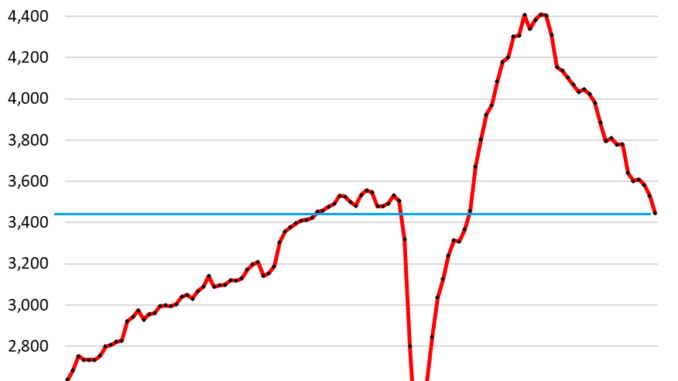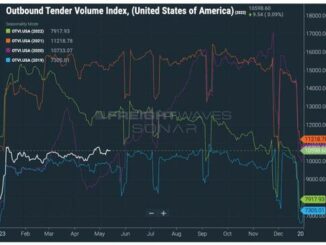
The headlines about massive layoff announcements had their intended psychological effect on workers.
By Wolf Richter for WOLF STREET.
The data has been pointing in the same direction for months: Employees have gotten more worried about their jobs after the purposefully scary headlines about global layoff announcements, and after seeing some actual layoffs, and after noticing that employers aren’t quite as aggressive anymore in trying to hire; and so they quit quitting their jobs.
And because workers quit quitting, employers have fewer job openings that the quitters left behind, and so employers need to hire fewer people to fill those newly vacated jobs. At the same time, actual layoffs and discharges have been dropping for months and are well below the pre-pandemic lows. These are signs that the massive churn in the labor force during the pandemic has slowed down to normal-ish levels.
Workers quit quitting: Voluntary quits fell to 3.38 million in January, according to the Bureau of Labor Statistics today, roughly back where they’d been in 2018-2019. The three-month moving average, which irons out the month-to-month fluctuations, fell to 3.45 million, also back to 2018-2019 levels.
Lower quits shows that workers are less confident and more worried, they’re less likely to walk out, and more likely to tough it out, which comes as a big relief for employers that then don’t need to hire people to fill the newly open jobs – and we’ll see that in the data below: fewer job openings, fewer hires, but also fewer layoffs and involuntary discharges.
Job openings, thanks to fewer quits, fell to 8.86 million in January, but were above where they’d been in October and in July 2023, and roughly in the same narrow range for the past seven months.
The three-month moving average rose a smidgen to 8.89 million. All of them are still far above the prepandemic levels, indicating a still hot employment environment, but the fact that they have dropped off from the crazy levels indicates that the era of massive churn has ended.
This data is based on surveys of about 21,000 work sites, released today by the Bureau of Labor Statistics as part of its Job Openings and Labor Turnover Survey (JOLTS). This is not based on internet job postings.
Job openings are not evenly spread. Over the past several months, job openings rose in Professional & business services, where many tech and social media companies are. They spiked in Information, on hiring for the AI mania. They’re at record levels in Construction. In Manufacturing and in Transportation, warehousing & utilities, job openings have dropped from the crazy peak and stabilized at levels that are far above pre-pandemic highs. And they have stabilized at very high levels in Health care & social assistance. Job openings in Wholesale trade and in Finance & insurance are back down to pre-pandemic levels. But in retail – the Brick-and-Mortar Meltdown, as I’ve called it since 2017 – job openings scraped along the bottom.
Layoffs and discharges continued to decline, dipping to 1.57 million. The three-month moving average also declined to 1.57 million. These are historically low layoffs and discharges.
In 2014-2019, layoffs and discharges averaged 1.8 million per month, part of the normal way of business. In March and April 2020, they averaged over 10 million.
This data is based on surveys of about 21,000 work sites, released by the BLS today, and not based on global layoff announcements in the media.
Some of those announcements of global layoffs in the tech sector were made for dramatic effect, it seems. For example, Alphabet announced in January 2023 that it would lay off 12,000 employees globally. Based on its quarterly reports however, its global headcount dropped only in one quarter, in Q2 2023, and by only 8,913 employees, and not by 12,000, and has been rising again since then. Google was laying off people through the left door but was hiring people through the right door, as we have seen.
So some of these grandiose layoff announcements turned into real layoffs, but not all, and they did so spread around the globe, and not only in the US, even as the same companies continued to hire. But they did have a massive psychological effect: people quit quitting.
Hires declined as people quit quitting. These are total hires: those needed to fill newly vacated jobs after people quit or were fired, and those needed for newly created jobs. So when the churn goes down, the number of hires to refill jobs vacated by the quitters goes down. But hires to fill newly created jobs have been strong, as we have seen in the employment reports.
In January, 5.68 million people were hired (three-month moving average), roughly in line with the hires in 2018.
Over 90% of those 5.68 million hires filled jobs left behind by someone who’d separated from the company for whatever reason. An additional 353,000 workers were hired to fill newly created jobs in January – the net addition to total nonfarm employment for January, according to the BLS employment report for January.
These are signs of much reduced churn. Books will be written about why workers quit their jobs in such large numbers during the pandemic – the Great Resignation, as it was called – and why they quit quitting in 2023. When these workers quit in 2021 and 2022, they left behind job openings that had to be filled, and so the job openings spiked, and hiring spiked to fill them, and then these workers quit again, and it started all over again, entailing a massive churn as workers arbitraged the labor market for higher pay and better working conditions and maybe better matching jobs. That churn has now calmed down, and the labor market isn’t that crazy anymore.
Enjoy reading WOLF STREET and want to support it? You can donate. I appreciate it immensely. Click on the beer and iced-tea mug to find out how:



